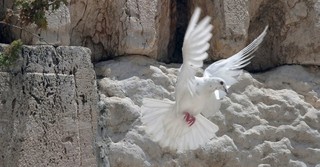Digging up Peter
Share

Historical texts and archaeological discoveries tell us about Peter’s life and times.
Archaeologist Dr. Donald Wimmer says that findings like the Roman theater in Sepphoris, a city in Northern Galilee, shed light on Peter’s home region. Galileans were likely more culturally sophisticated than many scholars suspected. It was “assumed that people from the north, including Peter, were out of the mainstream of culture,” Wimmer says. “Archaeology has shown us that Peter grew up in a multi-cultural environment.” This helped him minister in other Roman cultural centers like Pontus, Galatia, Cappadocia, Asia and Bithynia.
Archaeological work in Capernaum, Peter’s hometown, has unearthed a fourth-century, sandstone synagogue. It was built over a first-century synagogue, perhaps one frequented by Peter. Dr. John McRay writes that portions of the floor and walls of the first-century synagogue were found beneath the floor of the later building.
Nearby a house-church was unearthed that exhibits the structure of first-century homes, says Dr. Gene Green of Wheaton College. Wimmer remarks that it resembles the home Peter would have owned.
Though familiar with Roman culture, Peter was often counter-cultural. For example, many texts from the Roman Empire state that men have absolute authority over their wives and families. A book by Plutarch of Delphi even advises brides to follow the same gods as her groom. Peter says the opposite (1 Pet 3:1–7). Christ was the only God anyone should be worshiping, and he taught that a husband was a “co-heir of the grace of life with his wife,” says Green. “In an era where the husband had such authority and control, being co-heirs is a radical statement.”
In some ways, archaeology also bears witness to Peter’s effectiveness. Letters discovered from Pliny the Younger to Emperor Trajan discuss suppressing a strong Christian community in northern Asia Minor. Peter’s letters were written to this region. In many ways, he was the “rock” of the religion that later became a threat to the emperor.
Though we lack archaeological material that relates directly to Peter, what we do have helps us understand him. As archaeologist Gordon Franz says, “Archaeology puts life in context. I have traveled all over Galilee. And so I understand the mountains, the fishing, and the wind. I know what those storms are like. It is Peter who gets out of the boat and walks on water during a winter windstorm. [By being there] you get a feel for Peter and his life.”
Article courtesy of Bible Study Magazine published by Logos Bible Software. Each issue of Bible Study Magazine provides tools and methods for Bible study as well as insights from people like John Piper, Beth Moore, Mark Driscoll, Kay Arthur, Randy Alcorn, John MacArthur, Barry Black, and more. More information is available at https://www.biblestudymagazine.com. Originally published in print: Copyright Bible Study Magazine (May–June 2010): pg.32.